|
Main text below comes from the NYS Archives'
Guide to Records of the DOCS
web pages:
The NYS Archives' Guide to Records of the Department of Correctional Services describes more than 300 records series comprising approxi- mately 4,000 cubic feet of records. . .The records date from 1797 to about 1980 . . .
XXX
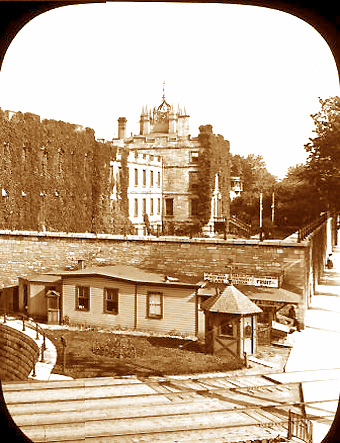
Above sepia facsimile is based on a grayscale NYS Archives photo that provides an exterior view of Auburn Prison circa 1880 - 1910.Click facsimile for full on-line NYS "The Digital Collections original as well as information about the photo, its subject matter and copyrights.
|
|
Auburn
Correctional Facility
Auburn Correctional Facility, located in Auburn, Cayuga County, is classified principally as a maximum security correctional facility receiving by transfer males 21 years of age or older. It functions as a general confinement facility, a detention center for males 16 years of age or older, and a diagnostic and treatment center. At present, Auburn has a population of approximately 1,700 inmates.
Auburn is the oldest existing State correctional facility. It was built to relieve overcrowding at Newgate Prison in NYC and received its first inmates in 1817. The "Auburn System" included separate confinement of inmates, congregate work during the day, enforced silence, lockstep walking, striped uniforms, and the use of the lash as punishment. It was the first institution to use separate cells for inmates. There was great interest in this new system throughout the penal community, and Auburn influenced the subsequent construction of many similar prisons in other states. Many of the harsher elements in the Auburn system eventually were phased out by the end of the 19th century.
In 1893, the State Prison for Women opened at Auburn. . . .In 1933, the State Prison for Women was transferred to Westfield State Farm and the space was utilized for a greatly expanded industrial facility for the male prison.
On August 6, 1890, the State's first electrocution was performed at Auburn. Subsequent electrocutions were performed at Auburn until 1914 when all State executions were transferred to Sing Sing Prison. . . .
XXX
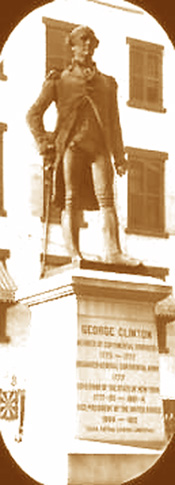
Above sepia facsimile is based on a grayscale NYS Archives photo that provides a view of the George Clinton statue by Henry Kirke Brown in Cadwallander Square (Colden Square) in Newburgh, Orange County. Formed in 1788, Clinton County is named for him. The inscription reads, "Member of Continental Congress 1775-1777; Brigadier General Continental Army 1777; Governor of the State of New York 1777-1795 and 1801-1804; Vice-President of the United States 1809-1912." Click facsimile for full on-line NYS "The Digital Collections original as well as information about the photo, its subject matter and copyrights.
|
|
Clinton Correctional Facility
Main text below from NYS Archives' Guide to Records of the DOCS
web page:
Clinton Correctional Facility is located at Dannemora, Clinton County. It is classified principally as a maximum security correctional facility for males 21 years of age and older.Clinton functions as a general confinement facility, a reception center for inmates from the 4th and part of the 5th judicial districts, a detention center for males 16 years of age or older, and a diagnostic and treatment center.
Clinton is the largest facility in the corrections system, presently confining approximately 2,700 inmates.
In 1844 (Chapter 245), the legislature authorized the construction of a prison to employ inmates in the mining and manufacturing of iron. Clinton Prison opened in 1845. While inmates were engaged in mining and smelting of iron ore during the 1800s, Clinton's inmate labor activity has consisted primarily of road work, forestry and the manufacture of iron, nails, fur hats, and clothing for State government. During its history, inmates transferred to Clinton have been those with lengthy sentences, discipline problems, or drug addictions. Also, inmates with tuberculosis were usually sent to Clinton to take advantage of its unique Adirondack climate and special hospital facilities. Electrocutions were performed at Clinton from 1895 until 1914, when all executions were transferred to Sing Sing Prison. . . .
Clinton was also the site of the Dannemora State Hospital for Insane Convicts which opened in 1900. . . . Matteawan State Hospital transferred to Dannemora all male inmates who had at least six months left to serve on their sentences. Males serving sentences for felonies in State prisons, reformatories, or penitentiaries, and who were declared insane, were also transferred to Dannemora. In 1912, the name of the institution was changed to the Dannemora State Hospital. In 1972, Dannemora closed and all inmates were transferred to Matteawan.
XXX
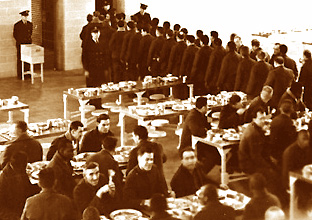 XXX
XXX
|
XXX
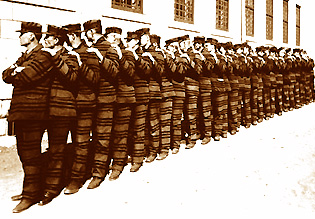 XXX
XXX
|
| Above sepia facsimiles are based on grayscale NYS Archives photos of Sing Sing Prison.
The image on the left shows a view of the dining hall in Clinton Prison, circa 1950.
The image on the right shows prisoners lined up at Dannemora Prison, Clinton County, 1905.
Click facsimile for full on-line NYS "The Digital Collections original as well as information about the photo, its subject matter and copyrights.
|
|
When Dannemora State Hospital closed, the site became the Adirondack Correctional Treatment and Evaluation Center. . . In 1975, the Center closed and the site was converted into the Clinton Annex, a medium security facility for male inmates. Camp Adirondack, a medium security work camp, was also established at the site in 1975. The following year, Camp Adirondack was transferred to Ray Brook and was renamed the Adirondack Correctional Facility.
NYS Reformatory at Elmira
Main text below from NYS Archives' Guide to Records of the DOCS
web page:
. . . Construction of the institution was approved by the legislature in 1871 . . . and it opened in 1876 as the NYS Reformatory at Elmira. [It] was one of the most important penal institutions in the country at the end of the 19th century. The philosophy of the institution, unique at the time, was that inmates should be reformed and that this reform was to be obtained through individualized treatment aimed at physical, intellectual, industrial, and moral training.
XXX
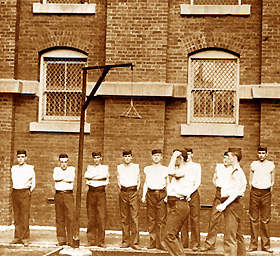 XXX
XXX
|
XXX
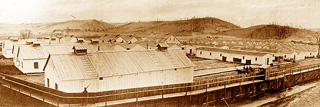
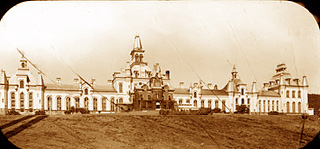 XXX
XXX
|
| Above sepia facsimiles are based on grayscale NYS Archives photos of Elmiral Reformatory.
The image left shows a view of the Elmira Reformatory exercise yard 1900.
The image top right shows a view Prison Camp during Civil War. Elmira, N.Y. From Print. Copyright J. E. Larkin. [The reformatory was built on a hill overlooking a national cemetery where many of the Confederate POWs remains rest.]
The image bottom right shows a view (circa 1890-1910) of the facade of the NYS Reformatory in Elmira, the first reformatory in the U.S. built in 1876. [Lines in image from cracks in Magic Lanten glass slide.]
Click facsimile for full on-line NYS "The Digital Collections original as well as information about the photo, its subject matter and copyrights.
|
|
Important segments of Elmira's program included indeterminate sentencing, vocational education, military squads, a detailed mark system, and the first broad use of parole in the country.
XXX

Above sepia facsimile is based on a grayscale NYS Archives photo that provides an interior view (1920) of a cell at the Institute for Defective Delinquents (IDD), Napanoch. Click facsimile for full on-line NYS "The Digital Collections original as well as information about the photo, its subject matter and copyrights. | | For more about IDD at Napanoch, access NYCHS presentation of
Eastern
NY CF
Centennial
Booklet
Excerpts
|
|
Despite the apparent early success of the Elmira program and its emulation by other states, subsequent investigations uncovered serious abuses in the program and eventually led to changes in the administration and program at Elmira by the turn of the century.
Elmira was under the general supervision of the State Board of Charities from 1876 to 1894 when it was placed under the jurisdiction of the State Commission of Prisons. Elmira was directed by a Board of Managers appointed by the governor.
In 1906, the legislature created a State Board of Managers of Reformatories to manage both Elmira and the Eastern New York Reformatory at Napanoch. When the Napanoch reformatory went out of existence in 1921, this Board continued to govern Elmira. In 1926, the legislature created a Department of Correction and placed the management of Elmira under the Commissioner of Correction. In 1933, the institution was renamed the Elmira Reformatory. It was renamed the Elmira Correctional Facility when the new Department of Correctional Services was established in 1970.
This NYCHS presentation is intended as an introduction to the treasures
to be found among the on-line archival sources used and cited in it.
Viewers are encouraged to use links provided above to access those sources.
Below are links to some of the subject-related pages on this NYCHS site.
|
